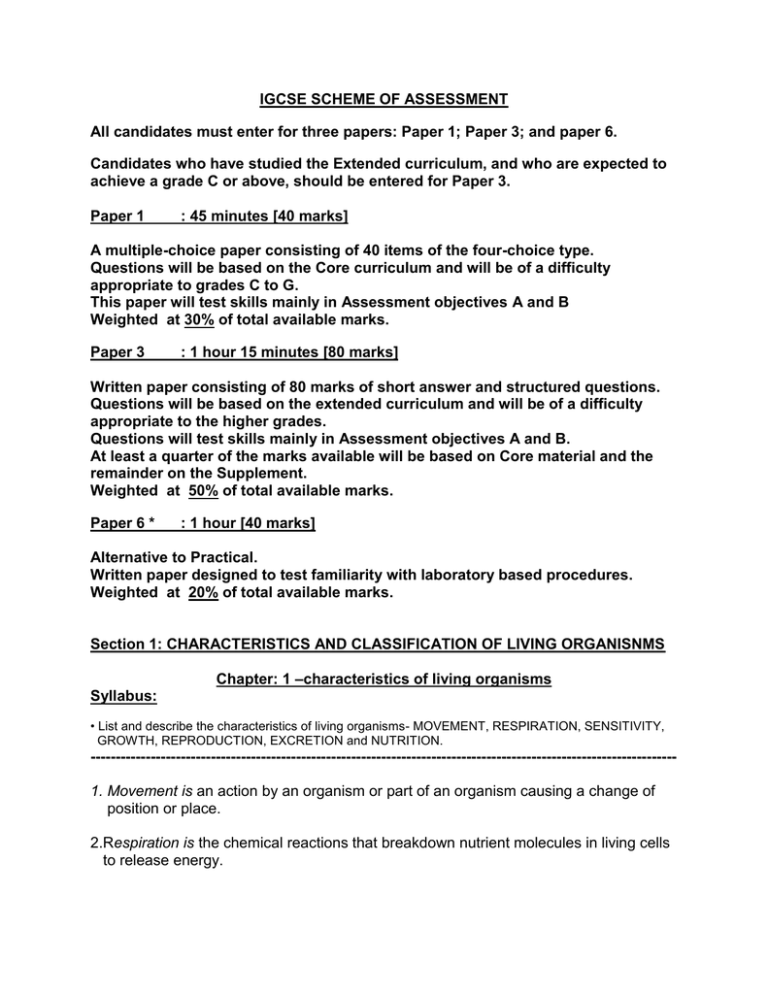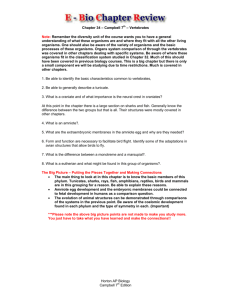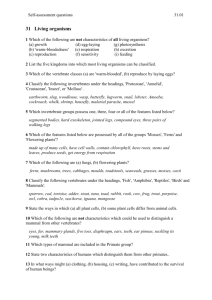igcse scheme of assessment
advertisement

IGCSE SCHEME OF ASSESSMENT All candidates must enter for three papers: Paper 1; Paper 3; and paper 6. Candidates who have studied the Extended curriculum, and who are expected to achieve a grade C or above, should be entered for Paper 3. Paper 1 : 45 minutes [40 marks] A multiple-choice paper consisting of 40 items of the four-choice type. Questions will be based on the Core curriculum and will be of a difficulty appropriate to grades C to G. This paper will test skills mainly in Assessment objectives A and B Weighted at 30% of total available marks. Paper 3 : 1 hour 15 minutes [80 marks] Written paper consisting of 80 marks of short answer and structured questions. Questions will be based on the extended curriculum and will be of a difficulty appropriate to the higher grades. Questions will test skills mainly in Assessment objectives A and B. At least a quarter of the marks available will be based on Core material and the remainder on the Supplement. Weighted at 50% of total available marks. Paper 6 * : 1 hour [40 marks] Alternative to Practical. Written paper designed to test familiarity with laboratory based procedures. Weighted at 20% of total available marks. Section 1: CHARACTERISTICS AND CLASSIFICATION OF LIVING ORGANISNMS Chapter: 1 –characteristics of living organisms Syllabus: • List and describe the characteristics of living organisms- MOVEMENT, RESPIRATION, SENSITIVITY, GROWTH, REPRODUCTION, EXCRETION and NUTRITION. --------------------------------------------------------------------------------------------------------------------1. Movement is an action by an organism or part of an organism causing a change of position or place. 2.Respiration is the chemical reactions that breakdown nutrient molecules in living cells to release energy. 3. Sensitivity is the ability to detect or sense changes in the environment (stimuli) and to make responses. 4. Growth is a permanent increase in size and dry mass by an increase in cell number or cell size or both. There might be a change in shape with growth. 5.Rreproduction is the processes that make more of the same kind of organism. 6. Excretion is removal from organisms of toxic materials, the waste products of metabolism (chemical reactions in cells including respiration) and substances in excess of requirements. 7. Nutrition is taking in of nutrients which are organic substances and mineral ions, containing raw materials or energy for growth and tissue repair, absorbing and assimilating them. Eg. Autotrophic, heterotrophic, parasitic etc. To carry out all these characteristics energy is needed. 1. The comparison of the characteristics of living organisms with those of non-living things – for example, what are the characteristic of life shown by a petrol engine. The comparison is clear when written in a table.] 1. The mnemonic, MRS GREN is useful to remember the seven characteristics. 2. Single-celled organisms, plants and animals all have these characteristics. Homework • Complete Worksheet 1.1 Characteristics of living organisms. • Think of a mnemonic for the seven characteristics of living things. • Explain why a car is not a living organism. • Make a set of revision flash cards with a characteristic of living things on one side and the definition on the other. • Answer Question 1.1 in the Coursebook. Chapter:2 CLASSIFICATION AND DIVERSITY OF LIVING ORGANISMS Syllabus 2.1 Concept and use of a classificatory system • Define and describe the binomial system of naming species • List the main features of the following vertebrates: bony fish, amphibians, reptiles, birds and mammals • Other classification systems e.g. cladistics (based on RNA/DNA sequencing data) • List the main features used in the classification of the following groups: viruses, bacteria and fungi, and their adaptation to the environment. 2.2 Adaptations of organisms to their environment • List the main features used in the classification of the following groups: flowering plants (monocotyledons and dicotyledons), arthropods (insects, crustaceans, arachnids and myriapods), annelids, nematodes and mollusks. 2.3 SIMPLE KEYS • Use simple dichotomous keys based on easily identifiable features. --------------------------------------------------------------------------------------------------------------------Concept and use of a classificatory system Classification: It involves sorting organisms into groups according to the features they have in common. Classification makes the identification of living organisms easier- there are more than a million different species already identified. The biggest group is a kingdom. There are five kingdoms, each with its own special and obvious features. The five kingdoms are: bacteria, protoctists, fungi, plants and animals. Each kingdom is divided into smaller groups which include: Phylum Class Order Family Genus Species - a group of related classes - a group of related orders - a group of related families - a group related genera - a group of related species but do not interbreed with each other. - a group of organisms of the same kind which can breed among themselves to produce their own offspring. Define and describe the binomial system of naming species Binomial system is the system used for naming organisms. According to this system, each organism is given a scientific name which is made up of two parts, the first is the genus name and the second is the species name. The genus name always starts with a capital letter. The species name always follows the genus name and is always written in small letters. Both names are Latin words. While the names are printed, they are in italics and are underlined while writing. This system is first introduced by Carl Linnaeus. This is a worldwide system used by scientists. Example: 1. The scientific name of human beings is Homo sapiens where the first word Homo represents the genus name and the second word sapiens shows the species name. 2. The scientific name of lion is Panthera leo. List the main features of the following vertebrates: bony fish, amphibians, reptiles, birds and mammals Classification of animal kingdom: Animals are classified into two groups: vertebrates and invertebrates. Vertebrates are animals with a backbone (part of an internal skeleton) and invertebrates are animals without a backbone. All have an internal skeleton made of either bone or cartilage. Classification of vertebrates: Vertebrates are divided into five classes. They are: Fish Amphibians Reptiles Birds Mammals Identifying features of bony fish: Skin covered with scales Fins present, used for swimming and balance the body in water Usually produces jelly covered eggs in water Have eyes but no ears Have lateral line along body for detecting pressure changes in water Cold blooded. Have gills used for breathing dissolved oxygen from the water. Identifying features of amphibians: Skin smooth, moist without scales. Skin is used to breathe under water. They have lungs used to breathe on land. Four limbs, back feet often webbed to make swimming more efficient in water. Produces jelly covered eggs in water Eyes and ears present Cold blooded. Examples: frogs, toads, newts and salamanders Identifying features of reptiles Skin dry, with scales to cut down water loss. Can live in dry regions as they do not have to return to water to breed. Four legs except snakes Lay eggs on land and eggs are covered with leathery, water proof shells which stop them from drying out. Have lungs to breathe air Eyes and ears present Cold blooded. Eg. Crocodiles, lizards, snakes, turtles, and tortoises Identifying features of birds: Skin covered with feathers Scales present on the legs Beak present Front limbs are modified into wings which they use to fly Lay eggs on land and the eggs are covered with hard shells Eyes and ears present Warm blooded-able to regulate their body temperature and can keep it constant even though the outside temperature changes. lungs to breath air Note: birds are very closely related to reptiles, and, like reptiles, have scaly legs and holes leading to their ear drums. Identifying features of mammals: Skin covered with fur or hair Two pairs of limbs Give birth to live young ones External ears (pinna) present Warm blooded lungs to breath atmospheric air Females have mammary glands to produce milk to feed their young Have four types of teeth-incisors, canines, premolars and molars Homework Make a large diagram of one vertebrate that lives locally, and annotate it to explain why it is classified in a particular class. Answer Questions 1.2 to 1.4 in the fish book Answer Revision question 2 on page 12 in the fish book. Other classification systems e.g. cladistics (based on RNA/DNA sequencing data) There are other classification systems e.g. cladistics (based on RNA/DNA sequencing data). Main features used in the classification of the following groups: viruses, bacteria and fungi, and their adaptation to the environment. Viruses They are very small: only about 100 nm across (100 times smaller than bacteria) Tbey are not actually living things because they are not made of cells, and they do not have any of the characteristics of living things, unless they enter a living cell. Only then they can reproduce They are particles made up of genetic material (a strand of DNA or RNA) surrounded by a protein coat called a capsid The only life process they show is reproduction (inside host cell) They are parasites which enter the cells of another organism called the host in order to multiply. They are very harmful because they can reproduce very fast and do not respond to antibiotics. They cause many diseases in humans like AIDS, common cold etc. BACTERIA They are small (1000 times smaller than a plant cell), single celled organisms. Like plant cells, they have cell walls but these walls are not made of cellulose. They contain substances called peptidoglycans. They have a cell membrane and cytoplasm containing glycogen granules Their cells have no nucleus. In bacteria, the DNA is kept as a long thread in the cytoplasm. Some bacterial cells have additional loops of DNA inside their cytoplasm called plasmids. Some have a slime capsule Some have one or more flagella for moving through water or other fluids. The structure of bacteria differs from animal and plant cells as they do not have chloroplasts or mitochondria. Bacteria feed by secreting enzymes onto their food source. The food is broken down and simple molecules such as sugars are absorbed. They are found everywhere-in the air, in water, in the soil and can survive harsh conditions such as heat, cold and drought. Eg. Escherichia coli FUNGI Some are unicellular (eg. Yeast) while others are multi cellular The main body of a multi cellular fungus is called mycelium which is composed of hyphae (thread like structures) which form a network. Each cell has a nucleus and cell wall. Their cell walls are made of chitin, not cellulose as in plants. They are not very like plants because they do not photosynthesize and never contain chlorophyll. They feed by secreting enzymes onto their food, digesting it and then absorbing it into their cells. They can feed on any decaying organic material. This is called saprotrophytic nutrition. Some produce spores in a sporangium or a cap. Eg. Mucor Nutrition in fungi (how fungi are adapted to obtain their food?) Most fungi are saprophytes but some are parasites. Saprophytic fungi feed on dead or decaying matter. They produce feeding hyphae which is get branched and spread across the food. These hyphae have large surface area and grow into the food They secrete enzymes to digest food outside the cells and absorb the nutrients. How the fungus spreads to new sources of food? (reproduction in fungus) Fungi produce spores in a sporangium or a cap The sporangium bursts and releases the spores which are carried in the wind. When the spores, which floats in air, are settled in a suitable place, each one grows in to a new feeding hypha and develops in to a mycelium. How fungi are adapted to survive in their environment? Bodies made of long threads that can grow through the soil or through whatever they are feeding on such as a piece of bread. Hyphae which can secrete enzymes to digest the materials they are growing on The ability to produce spores which can be carried away on the wind or on the feet of an insect Main features used in the classification of flowering plants (monocotyledons and dicotyledons All flowering plants are multicellular organisms Their cells have cellulose cell walls and cell sap vacuoles. Their cells contain chloroplasts They have roots, stems and leaves Reproduction can be by producing seeds, although asexual reproduction is also possible Have xylem and phloem They are divided into two groups-monocotyledons and dicotyledons Monocot plant Dicot plant The main differences between monocots and dicots are: Feature Monocots Dicots Leaf shape Long and narrow Broad Leaf veins parallel Branched cotyledons one Two Grouping of flowering parts: Have flowers with number e.g. petals, sepals and of parts divisible by three carpels Example Grass, date palm, bamboo Have flowers with number of parts divisible by five Mango tree, rubber tree, rose INVERTEBRATE ANIMALS Main features used in the classification of arthropods (insects, crustaceans, arachnids and myriapods), annelids, nematodes and mollusks. ARTHROPODS General features They are invertebrates-they have no backbone They have jointed legs ( the exoskeleton would prevent movement) They have a hard exoskeleton. This protects them, supports them and has muscled attached to it to allow them to move. In land-living arthropods it also stops their bodies from losing water and drying out. Their bodies are segmented Classification of arthropods Arthropodes are divided into four classes- insects, arachnids, crustaceans and myriapods. Class Insects Identifying features: Three pairs of jointed legs Usually have two pairs of wings One pair of antennae Body divided into three parts-head, thorax and abdomen Adult insects have a pair of compound eyes Examples-cockroaches, house fly, mosquitoes, bees, butterflies etc. Class Arachnids Spider scorpion Identifying features Four pairs of legs Body divided into two parts-cephalothorax and abdomen Several pairs of simple eyes Antennae absent Chelicerae or pedipalp for biting and poisoning prey Examples-spider, scorpion Class Crustaceans Identifying features Five or more pairs of legs Two pairs of antennae Body divided into cephalothorax and abdomen Exoskeleton is calcified to form a hard carapace Compound eyes Examples- crab, prawn, woodlouse, lobster etc. Class Myriapods: Identifying features They include the centipedes and millipedes Have long, thin bodies made up of many similar segments They have many pairs of legs. Ten or more pairs (usually one pair per segment) Have single pair of antennae Centipedes are usually fast-moving predators but millipedes move slowly and are herbivores Body not divided into thorax and abdomen Simple eyes Examples-lithobius, a centipede Homework ideas for arthropods Carry out Workbook Exercise 1.1 Leaves, parts a–c. If you build up a collection of photocopies of drawings that other students have done, you can provide a set of these for students to mark using the self-assessment check list for drawing. Answer Questions 1.5 to 1.6 in the Coursebook. ANNELIDS Earth worm Identifying features: Worms with bodies made up of many segments. Body is elongated and cylindrical covered with a mucus layer Mouth and anus present Have tiny, stiff hairs called bristles (chaetae) which help them to grip the surface they are travelling over. May have clitellum (reproductive structure) Eg. Earth worm, leech. NEMATODES Identifying features Long, thin, white, cylindrical, transparent body Body not segmented No definite head and no legs Do not have chaetae Body pointed at both ends MOLLUSCS snail Different types of shells Identifying features Soft bodies that are not divided into segments Body is enclosed in a hard shell made of calcium carbonate Have a soft muscular foot used for movement or burrowing May have eyes on tentacles Eg. Snail, pila (apple snail), pearl oyster, octopus etc. SIMPLE KEYS Keys are used by biologists in the process of identifying organisms. Generally they use a dichotomous key, which branches into two at each stage, requiring you to choose between alternatives. Examples: 1. The diagram shows a mammal. 2. The diagram shows a half-flower. 3. The diagram shows an animal. 4. The diagram shows a leaf. 5. The diagram shows a leaf. 6. The diagram shows an animal. 7. The diagram shows a fish. 8. The diagram shows an animal. 9. The diagram shows half a flower. 10. The diagram shows a section through a flower. Homework ideas for mollusks, nematods,monocots and dicots • Ask students to search at home and around the school grounds for examples of monocots and dicots. Depending on the facilities available, they could take digital photos of them and build up a display (with binomials where possible) for the lab. You could make this a team exercise, with one or two members of each team responsible for taking the photos, and others for digitally handling the photos, naming the plants, printing the photos with captions and making a display. • Workbook Exercise 1.1 Leaves, part d. • Answer Revision question 2 on page 12 in the Coursebook. WORK SHEETS WORK SHEET-1 1. Which two characteristics of all living organisms are involved when a person catches a ball? 2. An experiment is set up as shown. 3. Some yeast, sugar and water are mixed in a test-tube. The diagrams show the test-tube at the start and after one hour. 4. Which list includes only activities that are carried out by all living things? 5. What are characteristics of all organisms? 6. Which organisms carry out respiration, growth, movement and excretion? 7. What is a characteristic of all living organisms? 8. The diagram shows some organisms living in water. 9. A student was walking along a road when he saw an object under a tree. 10. The diagrams show two characteristics of living organisms. 11. Which organisms carry out respiration, growth, movement and excretion? 12. Living animals release carbon dioxide. 13. Which process involves the release of energy from food substances in all living cells? 14. Which process produces heat to maintain a person’s body temperature? 15. Which process removes the waste products of metabolism from the body? 1. Non-living things, such as a truck, have features that seem to be similar to those of living organisms. 2. Complete the following sentences about the characteristics of living organisms using only words from the list below. 3. Respiration is one of the characteristics of living things. WORK SHEET-2 TOPIC: CHARACTERISTICS AND CLASSIFICATION OF LIVING ORGANISMS 1. Which information is needed when classifying a frog using the binomial system? 2. The diagram shows how Homo sapiens (modern people) could have evolved from their ancestors. 3. The diagram shows features used in classifying the golden eagle. 4. The diagram shows an animal whose scientific name is Loxodonta africana. 5. The picture shows an animal. 6. Which shows an organism that has been named using the binomial system? 7. According to the binomial system, how should a human be named? 8. Which system is used for naming species? 9. The diagram shows some external features of a bird. 10. Which feature of vertebrates is present in fish and reptiles? 11. The diagram shows a newly discovered species. 12. Which kind of skin do amphibians have? 13. The table shows some characteristic features of four vertebrates. 14. The diagram shows some external features of a rat. 15. Which characteristics do fish have? 16. Which kind of skin do amphibians have? 17. An animal has four legs, fur and a tail. 17. Which type of living animal has a rough, dry, scaly skin? 11. The table shows the classification of four vertebrate animals.8 19. Which of the four vertebrates in the table is a mammal? 20. The diagrams show four different animals. They are not drawn to the same scale. 21. The table shows some characteristic features of four vertebrates. 1. Table 2.1 shows some of the external features of the five classes of vertebrates. 2. Fig. 1.1 shows a mammal. 3. Fig. 2.1 shows a bird. 4. Vertebrates can be classified by their external features. 5.a. Four of the classes of vertebrates and five possible descriptions of these classes are shown below. 6. Toads are amphibians. Only two species are native to Britain, the Common toad (Bufo bufo) and the Natterjack toad (Bufo calamita). Natterjack toads like warm sandy soil in open and sunny habitats, with shallow pools for breeding. Examples of these habitats are heathland and sand dunes. Common toads like cooler, more shady habitats, such as woodland. Many areas of sand dunes are being developed for camp sites. Heathland can easily change to woodland as trees grow on it. In the summer, woodland is colder than heathland due to the shade the trees create. These conditions suit the Common toad, but not the Natterjack. As a result of the changing habitats the Natterjack toad is becoming an endangered species. 7. Animals A, B and C are vertebrates. 8. South Uist is a small island which provides one of the few remaining summer habitats for a bird called the Corncrake (Crex crex). It lives in hay fields where it feeds on insects, worms and seeds. South Uist provides a good habitat because there are plenty of hay fields where the Corncrake can nest and there are few predators. However, a small mammal called the Hedgehog (Erinaceus europaeus) was released onto the island. The Hedgehog also has few natural predators and will feed on the eggs of Corncrakes, as well as on insects and worms. The number of Hedgehogs on South Uist has risen rapidly to 10 000 while Corncrakes are becoming endangered as their numbers worldwide are falling. 9. Table 1.1 shows some of the external features of the five classes of vertebrates. WORK SHEET-3 1. Fig. 1.1 shows a bacterium, a virus and a fungus. 2. 3. 4. Select from the list the name of the group of animals that best fits each description. 5. List an external feature of each of the following types of organism that would identify the group to which it belongs. 6. Figs 1.1 – 1.4 show organisms or parts of organisms (not drawn to scale). 7. Describe the main similarities between insects and arachnids. [3] 8. By means of a table, show the differences between insects and arachnids [5] WORK SHEET-4 1. Fig.1.1 shows the shells of five molluscs. 2. Fig. 1.1 shows seven species of fish that live on reefs in the Caribbean. 3. Fig. 1.1 shows five mammals. 4. Use the dichotomous key, Fig. 1.1, to identify the five vertebrate groups, A, B, C, D and E. 5. Fig. 1.1 shows six arthropods. 6. Fig.1.1 shows six arthropods, each of which could carry disease organisms. ----------------------------------------------------------------------------------------------------------------------------- ---------------





